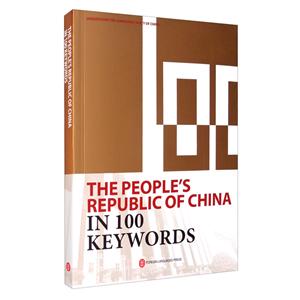-
>
(精)颤抖的镜头:卡帕二战回忆录(花口本)
-
>
(精)颤抖的镜头:卡帕二战回忆录
-
>
中国的民主
-
>
中华人民共和国六十年实录(套装共10册)
-
>
百年潮·中国梦(英文版)
-
>
新书)社会主义发展简史(大字本)
-
>
改革开放简史
The peoples republic of China in 100 keywords 版权信息
- ISBN:9787119122106
- 条形码:9787119122106 ; 978-7-119-12210-6
- 装帧:一般胶版纸
- 册数:暂无
- 重量:暂无
- 所属分类:>>
The peoples republic of China in 100 keywords 内容简介
《历史与现实:100个词了解新中国(英)》以词条为切入点,以讲故事的形式,简明阐释关于新中国的方方面面,帮助外国读者解疑释惑,了解中国、中国共产党。比如,开国大典、毛泽东思想、改革开放、科学发展观、四个全面……这些词条,既是线索,又是要点,便于查询。
The peoples republic of China in 100 keywords 目录
1 The Founding Ceremony of the PRC
2 Land Reform in Newly Liberated Areas
3 The War to Resist US Aggression and Aid Korea
4 Socialist Transformation
5 The First Five-Year Plan
6 1954 Constitution
7 The System of People's Congresses
8 The System of Multi-Party Cooperation and Political Consultation Led by the CPC
9 The System of Regional Ethnic Autonomy
10 The Five Principles of Peaceful Coexistence
11 The "Double-Hundred Policy"
12 "On the Ten Major Relationships"
13 The Eighth National Congress of the CPC
14 The "Four Modernizations"
15 The "Two Bombs and One Satellite" Projects
16 Spirit of Lei Feng
17 Spirit of Jiao Yulu
18 Spirit of "lron Man"
19 Restoration of the PRC's Seat at the UN
……
Chapter Two Reform and Opening Up Socialism with Chinese Characteristics
Chapter Three Advancing Reform and Opening Up in the New Era A New Journey of Socialist Modernization
The peoples republic of China in 100 keywords 节选
《历史与现实:100个词了解新中国(英)》: "On the Ten Major Relationships" is one of Mao Zedong's best-known speeches. This was the first time that Mao would present his ideas on building Chinese socialism. In early 1956, the socialist transformation of private ownership of the means of production was well under way, and the CPC Central Committee began to shift its focus to building socialism. Since the implementation of the First Five-Year Plan in 1953, China had accumulated three years of practical experience in building socialism, along with a deeper understanding of the shortcomings and mistakes of the Soviet Union in managing its economy. On this basis, China would draw on past experiences and explore its own path to building socialism. From February 1956, Mao conducted a thorough study of socialist construction, spending more than 40 days reviewing 35 reports from the ministries. He gradually summarized the requirements for sound management of ten major relationships, and formulated a structured thought on the subject. On April 25 he talked about the ten major relationships at an enlarged meeting of the Political Bureau of the Central Committee, then made some amendments based on the subsequent discussion. On May 2, Mao provided a systematic definition of the ten major relationships to the Supreme State Conference. The "Ten Major Relationships" represent ten problems to be addressed in building socialism in China: the relationship between heavy industry on the one hand and light industry and agriculture on the other; between industry in the coastal regions and industry in the interior; between economic construction and defense; between the state, the units of production and producers; between the central and the local authorities; between the Han nationality and minority nationalities; between the Party and non-Party; between revolution and counter-revolution, between right and wrong; and between China and other countries. As Mao pointed out, "It is to focus on one basic policy that these ten problems are being raised, the basic policy of mobilizing all positive factors, internal and external, to serve the cause of socialism." The first five relationships mainly concerned economic issues, while the latter five mainly concerned political problems. Therefore, he fundamental guidelines were carried out through mobilizing all positive forces relating to economic, political, and cultural issues to serve the cause of building socialism, and a strategy was defined that was best suited to the conditions of China and would help to create a powerful socialist China. ……
- >
伊索寓言-世界文学名著典藏-全译本
伊索寓言-世界文学名著典藏-全译本
¥6.1¥19.0 - >
罗庸西南联大授课录
罗庸西南联大授课录
¥13.8¥32.0 - >
苦雨斋序跋文-周作人自编集
苦雨斋序跋文-周作人自编集
¥6.9¥16.0 - >
【精装绘本】画给孩子的中国神话
【精装绘本】画给孩子的中国神话
¥17.6¥55.0 - >
朝闻道
朝闻道
¥10.2¥23.8 - >
罗曼·罗兰读书随笔-精装
罗曼·罗兰读书随笔-精装
¥40.6¥58.0 - >
唐代进士录
唐代进士录
¥19.1¥39.8 - >
月亮虎
月亮虎
¥17.8¥48.0
-
中国宫廷政治
¥12.5¥29 -
中国古代专制主义的政治学分析
¥11¥29 -
中国为什么要改革-思忆父亲胡耀邦
¥24.5¥48 -
当代中国政治思想史
¥9.9¥31 -
中国科举史话
¥6.4¥20 -
关于深化项目评审.人才评价.机构评估改革的意见
¥1.1¥2.2
















